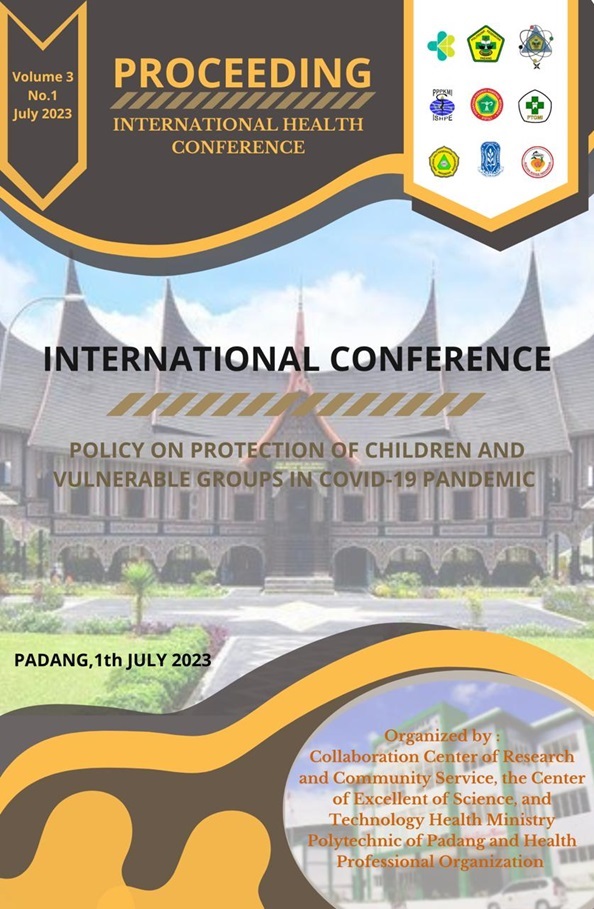Health Worker's Understanding of Haze Disaster Risk Management Collaboration in West Sumatra Province
Abstract
Forest fires cause a decline in the level of public health, either directly or indirectly. One of the public health services that requires good collaboration is health services at the Puskesmas. health workers on duty at the Puskesmas in dealing with disasters in their respective work areas. The collaboration target is integrated patient care for disaster victims. This study aims to determine the understanding of health workers in collaborative risk management for haze disaster in West Sumatra.The design at this stage is cross sectional to identify the characteristics of the respondents (age, gender, type of profession, education), knowledge, attitudes, and collaborative actions to reduce haze disaster risk at the same time. The target population of this research is all health workers in several districts in West Sumatra Province. The affordable population of the study is health workers in areas categorized as vulnerable to haze in the province of West Sumatra. The sample determined in the survey phase of the research using the Lamesshow formula (Lemeshow et al., 1990). Based on the above formula, the total sample size is 50 samples, with an anticipated sample drop out of 10%, so the total number of samples is 55 samples. Collecting data using primary data by means of interviews with a questionnaire instrument. The statistical test used in this study is the chi square test, which is a statistical test used to test the relationship between the independent variable (independent) and the dependent variable (dependent) on a categorical scale.The results of the quantitative research show that more than half of the knowledge level (60%) and positive attitude (51%) about collaboration in disaster risk management of haze haze are seen. And the actions or practices of more than half of the respondents or health workers have less action (64%) regarding collaboration for disaster risk management of haze. There is a relationship between the knowledge and attitudes of health workers with collaborative actions to mitigate the risk of haze disaster. Government involvement is needed to issue a collaborative policy for managing the risk of haze disaster to change the centralistic/spatial paradigm in disaster management. Health workers can improve their understanding of communication and motivation in collaborative disaster risk management for haze.
Downloads
References
Green, B. N. and Johnson, C. D. (2015) ‘Interprofessional collaboration in research, education, and clinical practice: working together for a better future’, Journal of Chiropractic Education, 29(1), pp. 1–10. doi: 10.7899/JCE-14-36.
Kemenkes.RI (2015) ‘Masalah Kesehatan akibat Kabut Asap Kebakaran Hutan dan Lahan Tahun 2015’. Jakarta: Infodatin.
Kemenkes (2013) RISET KESEHATAN DASAR 2013. Jakarta.
Kusumawati, W. (2015) ‘Bencana Alam dan Pendidikan interprofesi natural Disaster and Interprofesional education’, Pharmaciana, 5(1), pp. 93–100.
Maharani, C., Asrial, A. A. and Purba, B. A. (2020) ‘Edukasi dampak Kesehatan dan upaya pelrindungan diri Dari Bencana kabut Asap’, Jurnal Medic, 3(1), pp. 22–26.
Schneider, B. M. A. (2012) ‘Its time has come’. USA: Lippincott Williams & walkins.
Susilaningsih, S. F. et al. (2017) ‘Sosialisasi Model Praktik Kolaborasi Interprofesi Pelayanan Kesehatan di Rumah sakit’, Aplikasi ipteks untuk masyarakat, 6(1), pp. 10–13.
Tacconi, L. (2003) Fires in Indonesia : Causes , Costs and Policy Implications. Bogor: CIFOR.
Undang-undang (2007) ‘Undang-undang Republik Indonesia Nomor 24 Tahun 2007 Tentang Penaggulangan Bencana’.
Utomo, H. and Buana, F. C. (2017) Standar layanan kesiapan keluarga hadapi bencana. Jakarta: Kementerian Pemberdayaan Perempuan dan Perlindungan Anak.
WHO (2008) Infeksi saluran pernapasan akut (ISPA) yang cenderung menjadi epidemi dan pandemi. Jenewa: WHO.
WHO (2010) Human Resources for Health Framework for Action on Interprofessional Education & Collaborative Practice. Geneva Switzerland: Helath Professions Network and Midwifery.










